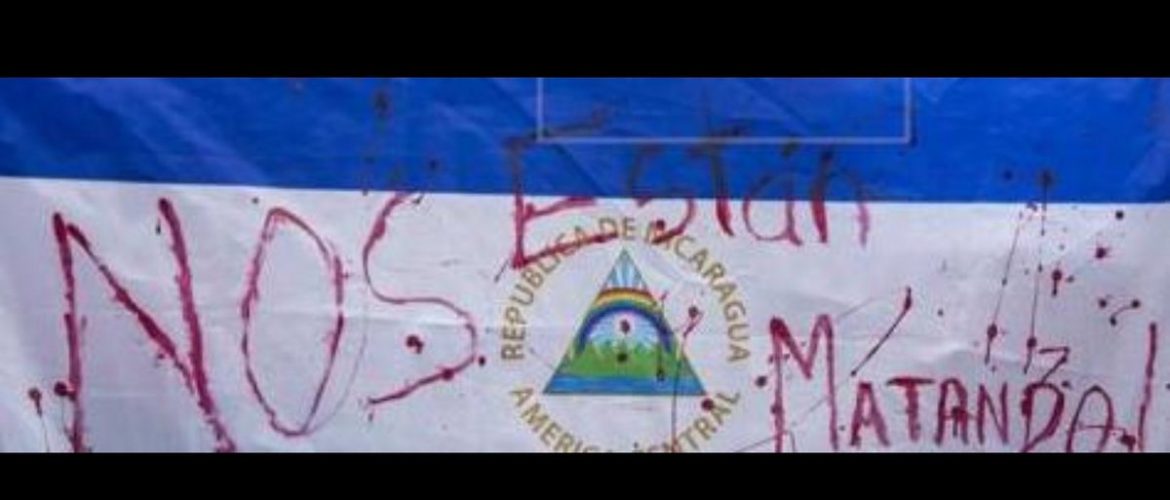To better understand the nature of the recent protests and violent repression in Nicaragua, I reached out to some of the people who organise the solidarity campaign #SOSNicaragua in Germany. I already knew one person who I had interviewed in 2016 about Daniel Ortega’s election victory and possible resistance scenarios as a result of that (the radio interview can be found here). This time I met and spoke with Ana, another young Nicaraguan who contributed to the effort of spreading information about the situation in her home country (again, the interview is available online here).
The interview was done in a bit of a rush as she and others had spontaneously organised a small protest of the Nicaraguan diaspora in Leipzig. With roughly 30 participants, it wasn’t big enough to be noticed by local papers or media, so I felt committed to help to get word out.
Apart from information on the group I also gained some interesting information about communication structures and dissent from that interview: For Ana and her co-organisers, the information tool has been Facebook. Not a mix of responsive media (twitter, instagram, blogs etc.), but Facebook exclusively. Although there are instagram and twitter profiles that cover the events, Facebook was the go-to place for her to a) get information and b) spread information.
The ease with which one can combine different media –videos of police brutality as evidence against hegemonic narratives of peaceful conduct; texts, or meme-like images– with a search engine that works on different levels –either you connect via common acquaintances (personal channels) or via hashtags (topic-related channels)– made the production and extension of a single-issue campaign page possible in a blink of an eye.
So far, so widely known. Also known is the fact that this form of communication necessitates a certain type of media-savvyness that comes most easily to younger, higher-educated people: Generating information via their recording devices (ie. mobile phones), sifting through information, and –most importantly– quickly spreading information on a variety of channels.
Facebook thus was the channel to gather support internationally, with the page’s credibility resting on the claim that the views expressed there represent those of “real” Nicaraguans (no internet trolls, no foreigners meddling in national affairs) and that it was up-to-date. The latter necessitates a constant input of the organisers –as nothing is more damning on a social media site than the lack of new content– which they solve with the two solutions Facebook excels in: getting visitors to comment (thus creating content) and linking to content already created by others.
One of the main sources for news updates was the twitter handle “Movimiento Autoconvocado Nicaragua” (@M_Autoconvocado), which is maintained by protest organisers from within Nicaragua. Many of them have been around since the first huge protests against cutbacks in the Pension System in 2013. The twitter hashtag #OcupyInss was created back then and is still in use, often being linked to by the “Autoconvocados.”
The “Self-Assembled,” as the word may be translated, function as one of the main sites where updates on current protest events, images (pictures like the one adorning this article, posters, animated gifs, so-called memes) and also calls for further actions (strikes, roadblocks) converge. Who administers the site and thus decides what is published in which form and what not, is out of my reach to ascertain. Yet, it is clear that the admin(s) of the Autoconvocados –so called to underline that they where not ordered to march or protest like the Ortega government repeatedly does with people on their payroll– have an academic background and knowledge of campaign strategies as well as media technologies like image manipulation, blogwriting etc.
Communication on the protests in Nicaragua has not been monopolized by #SOSNicaragua, the Autoconvocados or other groups of unclear affiliations, but certainly shows the divide between media like TV and radio, which are mostly controlled by the FSLN or Ortega’s extended family, and so-called social networks. #SOSNicaragua does not comment on content provided on the internet by TV and radio stations, but refers back to its own images, memes, calls for action and user comments. The Autoconvocados twitter feed also features mostly content generated by themselves, but does comment on press coverage of protest actions. Mostly, evidently, to debunk it.
#SOSNicaragua therefore is in the position of a nexus, a nexus between “insider” communication on recent events in the country discussed along political lines (and their affiliated media) and an instance of information geared towards a third party, namely a German population that is regarded as more or less informed about the incidents in Nicaragua.

